Zoom
Trash

Carrefour déploie sa blockchain sur son lait frais microfiltré. Le Machine Learning pour détecter si un miel est authentique. Le miel pourrait faire l'objet d'un nouveau test d'authenticité, grâce à un logiciel qui a « appris » à reconnaître certains grains de pollen.
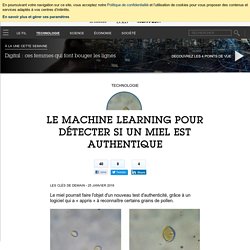
Le miel est l'un des aliments les plus frelatés ou mal étiquetés au monde. Technology and Islamic economy: Blockchain acknowledged as ‘transformational force’ in halal regulation. In the recently-released State of the Global Islamic Economy Report 2018/19, the authors found blockchain to be a prime megatrend and core technological driver in the Islamic economy, and especially in the Halal Food sector.

“[As] blockchain becomes widespread, driving decentralised, secure transactions and transparent data storage and as internet connectivity extends to physical matter, a potential impact could exceed US$3.9 trillion by 2025,” said the report. Que peut le deep learning pour l’agriculture ? La chaire AgroTIC consacre une étude au deep learning et à ses applications en agriculture.
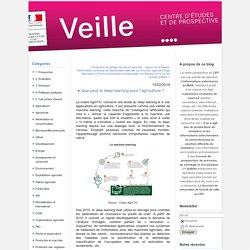
Deep Learning et Agriculture : une étude de la Chaire AgroTIC – AgroTIC. Les leaders mondiaux des céréales vont digitaliser leurs contrats avec l'IA et la blockchain. From Farm to Blockchain: Walmart Tracks Its Lettuce. Global Fishing Watch using big data for greater transparency with fisheries. Could an algorithm personalise caffeine intake and optimise alertness? According to US researchers, the dosing strategies described identified safe and effective caffeine-dosing strategies to maximise alertness under sleep-loss conditions.

Soon we'll use smartphones to trace our food on the blockchain. But there's a catch: We'll be traced, too. L’Internet des objets, une opportunité de 151 milliards de dollars en 2018 et 1 567 milliards en 2025. L’Internet des objets s’annonce comme un Eldorado. Selon le cabinet IoT Analytics, le déploiement s’accélère avec la perspective de porter le nombre d’objets connectés en service dans le monde à 7 milliards en 2018, contre 5,9 milliards en 2017. Et la croissance devrait se poursuivre de plus belle pour atteindre les 21,5 milliards en 2025. Ces chiffres excluent les téléphones fixes, smartphones, tablettes et PC. En incluant ces équipements numériques, reliés par construction aux réseaux, le nombre d’objets connectés passerait à 17,8 milliards en 2018 et 34,2 milliards en 2025.
Ce sont les applications de l’Internet des objets qui tirent le plus la progression de l’ensemble du parc des objets connectés. Traçabilité : Carrefour déploie la technologie de la blockchain à la filière de la tomate. Les distributeurs pourraient gagner 1,1 milliard d’euros avec leurs datas [Etude] Intelligence artificielle et santé. Des projets tentent de combiner les approches symbolique et d’apprentissage, afin de bénéficier à la fois du raisonnement de l’un et des performances de l’autre.

Ainsi, dans le projet Lerudi cité plus haut, la construction d’ontologies (IA symbolique) est faite à partir d’algorithmes numériques de fouille de texte. Emerging Opportunities for the Application of Blockchain in the Agri-food Industry. Nestlé's personalized nutrition pilot taps AI, uses consumer DNA. ISO includes QR codes and RFID tech in product labelling update. The future of seafood is bait-to-plate transparency on the blockchain. Can A.I. usher in a new era of hyper-personalized food? Cinq industries que la blockchain pourrait bousculer. Dans un récent article, la MIT Technology Review liste les secteurs d'activité les plus susceptibles d'être bouleversés par la blockchain.
Voici les cinq industries identifiées. L'énergie Aujourd'hui de nombreux intermédiaires (bien souvent des poids lourds) s'immiscent dans la distribution de l'énergie. First-of-its-kind blockchain technology to trace Halal food launched in Dubai. Industry experts from Indonesia, China, Pakistan, Australia, Nigeria and Malaysia have come together, spending six months on the research process, developed by HLC Technologies FZCO.

In an interview with FoodNavigator-Asia, Dr Sulaiman Liu, co-founder of HalalChain, shared that the technology uses smart IoT devices, RFID, Sensor, LoRa, smart cameras with AI, and so on, for data gathering. Future of food distribution is local: Foodshed.io creates transparent supply chain using blockchain. Blockchain of food: trazabilidad extrema - Cajamar Caja Rural. La Blockchain : la révolution de la traçabilité. Big Data Comes to Dieting. [Ces Startups qui changent le monde] Provenance met la blockchain au service de la traçabilité alimentaire. Traçabilité : Carrefour lance sa blockchain du poulet. Blockchain technology introduced to Pacific tuna industry - Food & Beverage. Environmental organisation WWF and its partners have introduced blockchain technology to the Pacific Islands’ tuna industry, the first of its kind for this region, to help stamp out illegal fishing and human rights abuses.
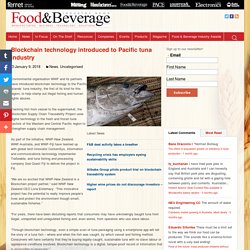
Tracking fish from vessel to the supermarket, the Blockchain Supply Chain Traceability Project uses digital technology in the fresh and frozen tuna sectors of the Western and Central Pacific region to strengthen supply chain management. As part of the initiative, WWF-New Zealand, WWF-Australia, and WWF-Fiji have teamed up with global tech innovator ConsenSys, information and communications technology implementer TraSeable, and tuna fishing and processing company Sea Quest Fiji to deliver the project in Fiji. “We are so excited that WWF-New Zealand is a Blockchain project partner,” said WWF-New Zealand CEO Livia Esterhazy. The Rhythm of Food: Search data on food-related terms. Why blockchain won’t fix food safety—yet. How Blockchain Could Transform The Way You Buy Your Groceries. Walmart, Kroger and others are looking to blockchain to help prevent the 48M annual food-borne illnesses in the US.
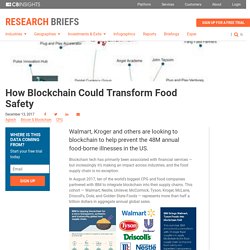
Blockchain tech has primarily been associated with financial services — but increasingly it’s making an impact across industries, and the food supply chain is no exception. In August 2017, ten of the world’s biggest CPG and food companies partnered with IBM to integrate blockchain into their supply chains. This cohort — Walmart, Nestle, Unilever, McCormick, Tyson, Kroger, McLane, Driscoll’s, Dole, and Golden State Foods — represents more than half a trillion dollars in aggregate annual global sales. Is grocery store salmon really wild? Blockchain has the answer. Perspectives: Algorithms May Have Developed Your Favorite Coffee Drink.
Most individuals likely don't spend much time wondering how the products they use every day are developed.
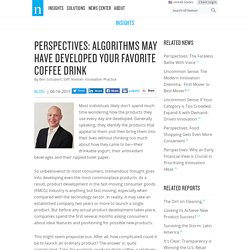
Generally speaking, they identify the products that appeal to them and then bring them into their lives without thinking too much about how they came to be—their drinkable yogurt, their antioxidant beverages and their rippled toilet paper. So unbeknownst to most consumers, tremendous thought goes into developing even the most commonplace products. As a result, product development in the fast-moving consumer goods (FMCG) industry is anything but fast-moving, especially when compared with the technology sector. In reality, it may take an established company two years or more to launch a single product. But before any actual product development takes place, companies spend the first several months asking consumers about ideal features and positioning for possible new products. This might seem preposterous.
Comment Coca-Cola affine ses recommandations... 1,9 milliards de boissons vendues chaque jour dans le monde, en additionnant toutes les marques dans le giron de Coca-Cola.
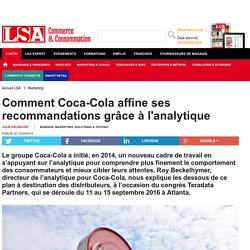
FoodProfiler: The NPD app that tracks the 'what, when and why' of consumer food choices. Developed by consumer behaviour researchers at Wageningen University and launched to the general public last week, the information collected can be used by food businesses to fine tune product development; by governments to improve food policy on health and sustainability; and by individual consumers who want to know more about their diet and the impact of their food choices.
It works by collecting data from users in the Netherlands. This will include how often an individual eats a certain product or product category and the motives behind this, as well as the time of day the user is eating and how much of each product is consumed. FoodProfiler in action. © Wageningen University.
Exploring big data for understanding consumer food habits and health. Source: Richfields New ICT technologies bring opportunities for researchers to monitor behaviours, collect information around food choice, and provide personalised feedback. Increasingly, we use mobile apps and tech-wear, recording real-time data about health and behaviour. We might also obtain access to other valuable data, such as health and medical information.
Every day, consumers and businesses generate “big data” – large volumes of information, that offer detailed descriptions of behaviours, including time and place (e.g. using GPS). Intelligence artificielle et Big Data pour l’analyse et la gestion d’alertes alimentaires. Data from retail grocery scanners can narrow down suspected items. Researchers showed that with as few as 10 medical-examination reports of foodborne illness they can narrow down the investigation to 12 suspected products in a few hours. The goal is to provide a short list of suspect products for laboratory testing in a timely fashion using a likelihood-based method (LM) approach with spatial-temporal retail scanner data and case reports.
Accelerate outbreak investigation Using retail scanner data with spatial information already collected at a grocery store/supermarket with confirmed geo-coded cases reported from the public health agency makes it possible to quickly identify “suspect” products that should be tested in the laboratory and investigated further. Big data project set to reveal consumer food habits & health. Commerce prédictif : Big Data, la nouvelle... Les données, une richesse insuffisamment exploitée par les entreprises "Les enseignes disposent aujourd’hui de volumes de données croissants de tous types : données structurées (CRM, fichiers excel, etc.) ou non structurées (réseaux sociaux, avis consommateurs, etc.) avec des consommateurs de plus en plus ouverts et disposés à fournir des informations personnelles.
Une étude menée par IBV Retail en 2013, révèle d’ailleurs que 90% des gens sont prêts à fournir des informations et à passer jusqu’à 20 minutes pour remplir un formulaire*, à condition qu’ils bénéficient d’un vrai service à valeur ajoutée. Qui n’a jamais donné son numéro de téléphone portable afin d’être averti de l’heure d’une livraison ? Bien que ce ne soit pas le genre d’information que l’on divulgue de prime abord. Or, elles permettent d’avoir un point de contact supplémentaire avec le client. Malheureusement, ces données restent encore trop souvent inexploitées à l’heure actuelle. Self Data – La FING publie la deuxième édition de son Cahier d’exploration MesInfos. La Fondation Internet Nouvelle Génération (FING) vient de publier la deuxième édition de son Cahier d’exploration consacré à la thématique des Self Data et s’appuyant sur une expérimentation conduite dans le cadre du projet MesInfos. 300 clients de six grandes entreprises françaises (dont Les Mousquetaires) ont eu, pendant huit mois, accès à leurs données dans un « cloud personnel » et à des services pour les trier, visualiser et utiliser à des fins pratiques.
Ce Cahier d’exploration en présente les résultats et développe plus largement une analyse du marché des Self Data et des services existants, ainsi que des défis posés. Pour la FING, l’importance croissante des données personnelles dans l’activité des organisations (entreprises, administrations) est un facteur fort de la crise de confiance qui touche le « cœur de [leur] relation » avec les individus, lesquels réclament plus de transparence.
Cahier d’exploration "Self Data" Ce nouvel ouvrage de référence sur les "Self Data" fait suite à la publication d’un premier Cahier d’exploration en mai 2013. Il s’enrichit notamment des enseignements de 2 ans d’expérimentation, d’une veille importante sur un marché émergent et propose de relever 10 défis pour les années à venir. Que se passerait-il si, demain, les organisations partageaient les données personnelles qu’elles détiennent avec les individus qu’elles concernent, pour qu’ils en fassent… ce qui a du sens pour eux ? Open Food Facts : l’encyclopédie en ligne de l’agroalimentaire. Coheris, lauréat du Trophée de l’innovation Big Data Paris 2015, pour son moteur de recommandation temps réel.